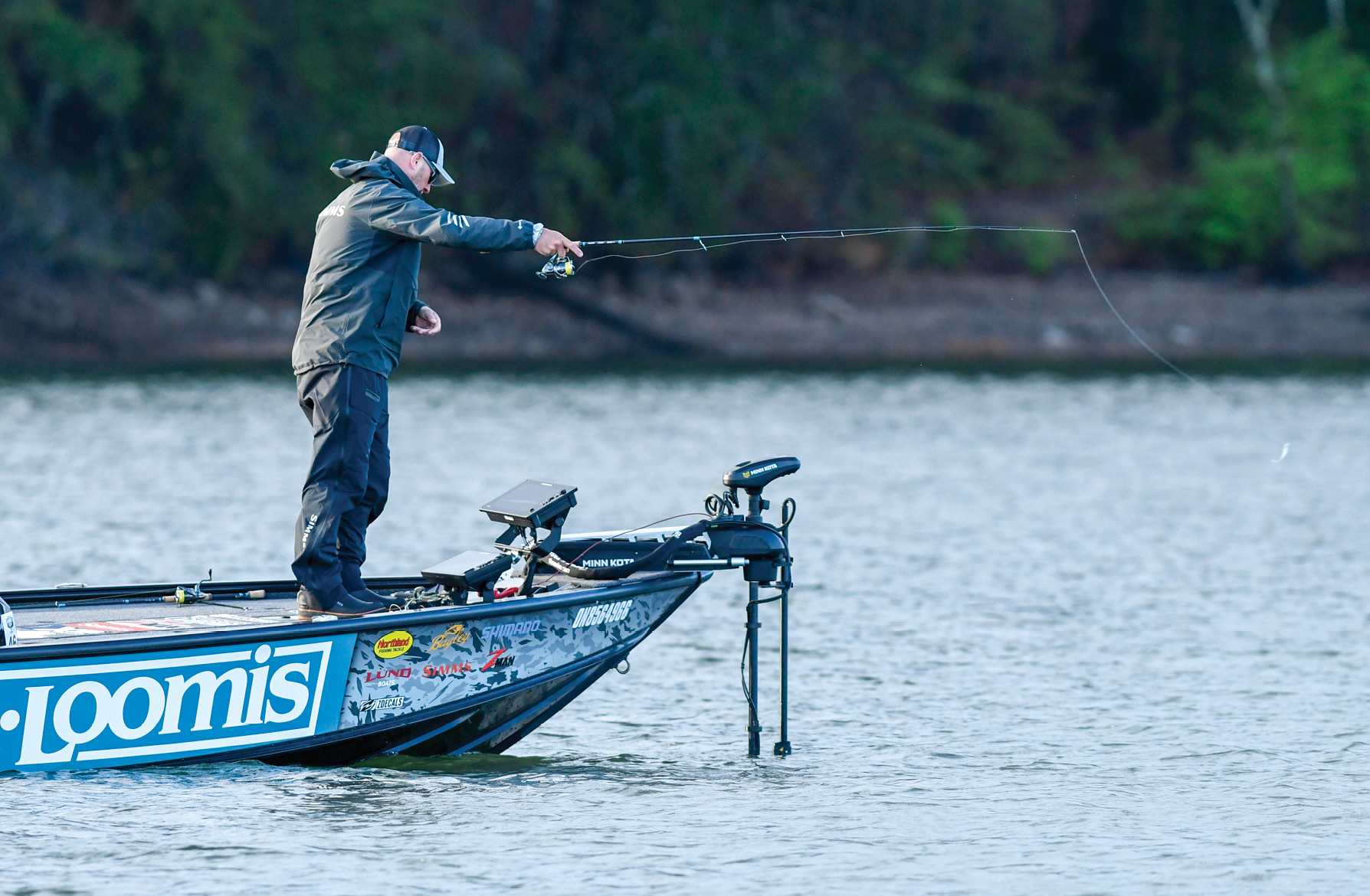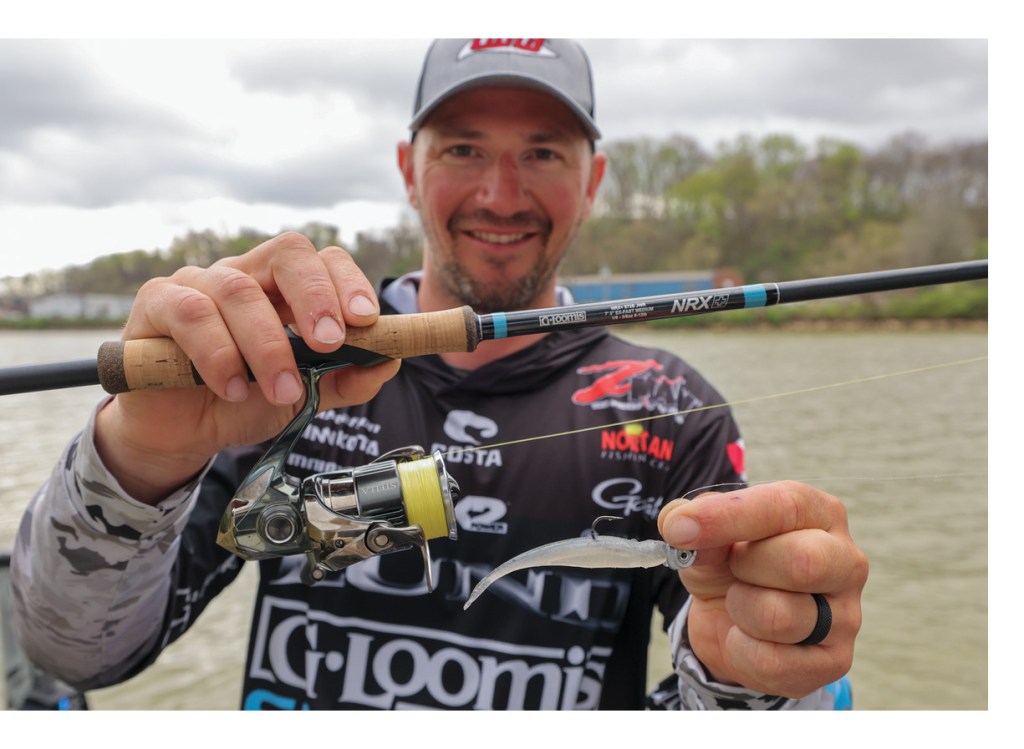
When a warm front slides across Northern fisheries, it’s certainly good for anglers. But, does that inspire bass to bite? Elite Series pros debate the scenario and offer guidance on how to fill a limit regardless of opinion
You can’t blame Northern anglers for thinking that Mother Nature isn’t fair when it comes to late-season fishing.
While Southern brethren get plenty of “nice” days to extend their fishing season deep into the winter, Northern dudes have a short window that tightens with some pretty brutal weather.
And then ice blankets the lakes.
But there is a bright side, at least for the weathered, hard-core anglers who have learned that winter bassin’ can be pretty incredible from late fall to freeze-up.
The bass will bite when your fingers are numb, when it’s snowing or the wind is blowing. The angler who can withstand the weather has a good chance of loading the boat with quality bass.
“Once you get that cold snap in the early fall, the fish get programmed to eat as much as they can before the ice comes on,” insists Bassmaster Elite Series pro Chad Pipkens. “They may not be as shallow as they were in the fall, but they school up and you can have incredible fishing days.”
Of course, weather changes can affect bass fishing during the late fall and winter just as they do the rest of the year.
And that’s where you can get some disagreement among anglers. For example, when those rare, unseasonably warm fronts shroud the North, some anglers say it can impact fishing negatively, while others say it turns the fish on.
Here are four perspectives.

Jeff Gustafson, far northern border
The defending Bassmaster Classic champ says that bass don’t often bite well during warm fronts along the Canadian border where he lives. Once the far Northern region rolls into September, anglers want the colder days.
“We all love those October days when it’s 75 and beautiful, but those are the toughest days for us,” he says. “It seems especially tougher for smallmouth fishing — kind of like getting a cold front in June.”
That’s when Gussy says you have to “bust out more finesse and realize you’re not going to get as many bites as you will when the air temp is below freezing in the morning.”
The Canadian pro believes that fish get lazier during warm fronts, so you have to be more patient.
He says they are in the same places where you catch them in cold weather — humps, points or deeper flats.
“Instead of being on top of the structure waiting for something to come into their faces when it’s cold, they will drop deeper and lay closer to the bottom and be harder to see on the electronics,” Gussy describes. “When smallmouth are 2 to 3 feet off the bottom, they tend to be easier to catch than when they are snug to the bottom.”
During warm fronts, he limits himself to three or four baits. It might be a Z-Man Jerk ShadZ, a Ned rig or a drop-shot rig with smaller baits. Also, he will have to rotate through colors more than normal.
“The fish’s window of awareness and willingness to swim to eat your baits decreases, so you have to put the bait in their space more than normal,” Gussy adds.
He can’t explain what causes it but says it might be because the bait gets lower and isn’t as active.
“On cold front days, you might catch 50, but on warm front days, you may only get 15 to 20 chances,” he adds.
Neil Vande Biezen, Michigan inland lakes
Put this Kalamazoo, Mich., angler in the camp that says warm fronts make for a great day of winter fishing.
And he should know. As a northern Michigan guide, tournament angler and frequent guest on Zona’s Awesome Fishing Show, “Vandy” fishes often throughout the winter.
“These fish live in cold weather,” he says. “When we get those warm fronts, I think it activates them. They want to eat. But when you get a cold front, it can make for a tough day.”
For example, in November 2022, a warm front passed through the area and he was catching 22 to 25 pounds of largemouth on a nearby lake every day until it got cold again.
“The same deal occurred in December and I smashed them again,” he notes.
Vandy says that when the water temperature gets into the low 40s, bass are schooled in deeper wintering holes. When the water is cold like that, he opts for bottom baits, such as a Strike King Coffee Tube, a 3.25-inch Strike King Rage Swimmer, a blade bait like a Silver Buddy or even a 3/4-ounce Strike King Thunder Cricket bladed jig or Strike King Red Eyed Shad lipless crankbait.
“Most people wouldn’t think of fishing a bladed jig or even a lipless crankbait in cold water, but they bite it, especially in the shallower inland lakes,” he explains. “I’ll fish them out into 20 feet of water or more.”
He adds that he fishes the Thunder Cricket much like a jig, either yo-yoing it off the bottom or slowly crawling it on lakes with deep vegetation.
“When fishing for smallmouth, I will yo-yo or slow roll a Red Eyed Shad over the bottom,” he describes. “Some of my best bags during cold-weather months have come that way.”
When a cold front moves in, he downsizes to a tube jig or a Damiki rig with a Strike King Baby Z-Too.
“You have to slow it down,” he explains. “But during those warming trends, you can fish a little more aggressively, but always on or near the bottom.”

Chad Pipkens, Great Lakes region
The Bassmaster Elite Series pro from Michigan also believes the warmup triggers bass activity, but he notes that Great Lakes fisheries are so big it takes a while for the temperature to affect them.
“I believe a changing barometer is a bigger factor in bass activity,” he explains. “It’s not like down South, where the back of a pocket may warm up 7 degrees.”
Pipkens says there are days when you can find the bass stacked but not eating on the Great Lakes.
“But if you find them during a warm spell, they will bite,” he insists. “You can have 50- to 100-fish days on Erie where you don’t even have to move the boat.”
He targets deep gravel flats and rockpiles on Erie and monitors his electronics for baitfish as well as bass.
When they are biting, he adds, it doesn’t take 10 different rod setups.
“The key is to match whatever the primary forage is on that body of water,” he says. “When you get those warm fronts, those fish will be feeding. You can catch them on crankbaits or blade baits or can slow down and fish a drop-shot rig, but when they’re biting, you don’t have to.”

Clifford Pirch, Central Arizona
While most people relate to Arizona as hot desert country, Pirch’s home of Payson sits at a high elevation where cold weather is common in the winter.
“Our air temps get really cold on area lakes,” he says. “A lot of times, the air comes off the nearby mountains and cools off those lakes in the winter. I’ve left my house when the temperature is close to zero and it’s snowing.”
Given those conditions, he says, a warm front after a cold front will pull the bass up on rock shores or bluff banks.
“We get a lot of good sunlight, so warm, sunshiny days can heat the water and the fish get more active,” he explains.
When that happens, he searches rocky areas exposed to the most sunlight and out of the wind. Those areas hold crawfish and bluegill that the bass are eating that time of year.
Multiple warm days make it even better.
“The more heat you get in that water, the more the forage gets active,” he says. “The fish really spend a lot of time eating crawfish out where I live.”
If his higher-elevation lakes get multiple days of warm sunshine, the fish he was catching in 15 to 25 feet along rocky veins or bluffs may move up as shallow as 2 feet.
“Places like the end of a bluff wall where it breaks up, or transition areas where the bottom turns from sand to gravel or to chunk rock,” he describes. “Big river rock on clay banks holds a lot of crawfish, too.”
It’s there where he fishes a football jig with a crawfish imitator or medium to shallow crankbaits. If he notices shad flitting around the surface, jerkbaits and glidebaits can play.
Originally published in Bassmaster Magazine 2024.





